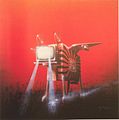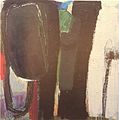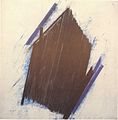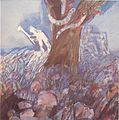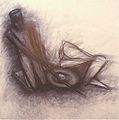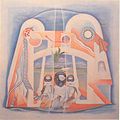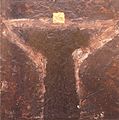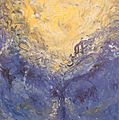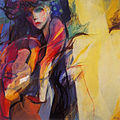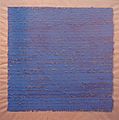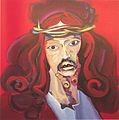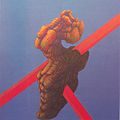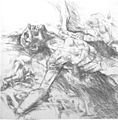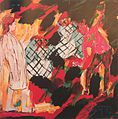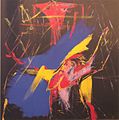Güglinger palm cloth
Horst Peter Schlotter : The creation of the four-footed animals (No. 3).
Alfred Bast : The Creation of Adam (No. 4).
Gerlinde Beck : The wedding of Adam and Eve (No. 6).
Horst Rellecke : Israel worships the golden calf (No. 15).
The Güglinger Palm Cloth was created in 1988 and hangs on the north wall of the Mauritius Church in Güglingen . The palm cloth replaces a documented historical palm cloth that was burned in 1849 and was composed of 60 individual images. The new palm cloth consists of 40 individual images that were donated by 40 German artists and, like the images on the old palm cloth, show scenes from the Old and New Testaments .
Note: For copyright reasons, Wikipedia cannot show an overall picture of the palm cloth. Overall pictures: see web links .
The historical palm cloth from the 15th century
Source: #Klunzinger 1847 .
Palm or Lent cloths were used to cover the sanctuary during Lent. The historic Güglinger palm cloth was hung in the Mauritius Church in Güglingen every year "from the Palm Festival (hence the name) to Easter Monday between the nave and the choir of the church". After the Güglingen parish priest Karl Klunzinger (1799–1861), the palm cloth was created in the 15th century:
- The palm cloth comes from the time before the Reformation , because picture no. 24 with the Annunciation contained an inscription with the heavenly greeting “Ave, Maria, gracia plena”. The text comes from the Latin translation of the Bible, the Vulgate , which was not recognized by the Protestants.
- "From the whole style in which it is kept, it can be concluded that it is about the same age as the one in Zittau." The Great Zittau Lent Cloth dates from 1472 (see picture).
The palm cloth was a 7.20 m high and 4.30 m wide canvas curtain and was divided into 60 square fields with a side length of about 70 cm. The fields showed representations from the Old Testament (nos. 1–21) and from the New Testament (nos. 22–60).
Karl Klunzinger remarked in 1846 on the artistic and historical value of the palm cloth: “The strangeness of the raised features corresponds to the author's not very masterful brush and the transfer of the costume of his time to biblical history. Nevertheless the piece is valuable partly because of the well-preserved colors, partly because of its contribution to the knowledge of the taste of that time, partly because of its impressive size, and partly because of its age. "
Around 1751 the dilapidated medieval church was replaced by a new building. “This baroque church would probably still be in place today if it hadn't fallen victim to the notorious city fire of March 7, 1849. The church tower burned like a brightly shining torch, the nave with all its furnishings, including the unique palm cloth, was destroyed to the ground. ”Three years earlier, in 1846, Karl Klunzinger had described the palm cloth in detail and delivered it with it Basis for the modern version of the palm cloth.
For comparison: the medieval Große Zittauer Lenten Cloth from 1472 with 90 individual images.
The new palm from 1988
Source: #Rall 1988 , page 8, #summer 1988 .
During the renovation of the Mauritius Church in the seventies, a conversation between the then pastor Werner Marquardt and the architect Heinz Rall arose the desire for Klunzinger's "texts to create images again". On the occasion of the 800th anniversary of the city of Güglingen in 1988, the Protestant parish decided, on the initiative of Heinz Rall, to follow the request for a new palm cloth. Thereupon 120 German artists were written to requesting donations of pictures. Some of the artists contacted, the request for free pictures met with rejection, while the majority took part in the project. According to Heinz Rall, those responsible for the project took the following considerations as a basis: “In contrast to old palm towels that were made from a single source or in a workshop, the new Güglinger palm towel should consist of a large number of individual contributions. The pluralism of different styles, as a reflection of the current situation in the visual arts, is expressed. The initiators are aware of the problem of this coincidental combination, but also see a chance in the connecting biblical theme and the framework of square picture formats of 70 × 70 cm for a coherent overall composition. "
From 40 of the submitted designs an approx. 6.00 x 3.70 meter large palm cloth was made, which today hangs on the north wall of the Mauritius Church. The smaller format compared to the historical palm cloth is due to the changes in space in the church. The 40 individual motifs are arranged in five columns and eight rows. Pictures 1–15 show scenes from the Old Testament, and pictures 16–40 scenes from the New Testament. While the historical cloth showed the scenes strictly according to their biblical sequence, with the new cloth the scenes in two cases were not arranged according to the biblical order, but with due regard for the symmetry of the picture.
Single images
Sources: #Rall 1988 , #Schlenker 1935 , #Klunzinger 1847 .
Since not all rights holders of the individual images have given their consent to publication in Wikipedia, individual images may be missing.
| → Column legend and sorting | ||||||
| Legend | ||||||
|
||||||
| Sorting | ||||||
| No. | Old no. |
image | Picture theme | Bible passage | Artist |
|---|---|---|---|---|---|
| 1 | 1 | The Divine Trinity | Matthew 28:19 | Georg Meistermann | |
| 2 | 2 | The fall of the angels | Genesis 6: 1-4 | Helga Gerken-Grieshaber | |
| 3 | 3 | The creation of the four-footed animals | Genesis 1, 24 f. | Horst Peter Schlotter | |
| 4th | 4th | The creation of Adam | Genesis 2: 7 | Alfred Bast | |
| 5 | 5 | The creation of Eve | Genesis 2:20 ff. | Detlef Bräuer (Pfaffenhofen) | |
| 6th | 6th | The wedding of Adam and Eve | - | Gerlinde Beck | |
| 7th | 7th | The fall of man | Genesis 3: 1 ff. | Josef Wiesner | |
| 8th | 7th | The fall of man | Genesis 3: 1 ff. | Ritzi Jacobi | |
| 9 | 9 | The hard work of the first people | Genesis 3: 17-19 | Klaus Bushoff | |
| 10 | 11 | Cain murders his brother Abel | Genesis 4: 5-9 | Peter Jacobi | |
| 11 | 12 | Lamech's words to his two wives | Genesis 4:23 | Jürgen Brodwolf | |
| 12 | 13 | The flood | Genesis 8, 7 f. | Ursula Laquay-Him | |
| 13 | 14th | The sacrifice of Abraham | Genesis 8: 20-22 | Gerhard Dreher | |
| 14th | 15th | Legislation on Sinai | Exodus 19-20 | Gertraud Ellinger-Binder | |
| 15th | 16 | Israel worships the golden calf | Exodus 32: 1-6 | Horst Rellecke | |
| 16 | 23 | Wedding ceremony of Joseph with Mary | Luke 1:27 | Josef Kirch | |
| 17th | 26th | The birth of Jesus | Luke 2, 1 ff. | Anneliese Hermes | |
| 18th | 32 | The twelve year old Jesus in the temple | Luke 2: 41-50 | Heinrich Klumbies | |
| 19th | 28 | The three wise men from the Orient | Matthew 2: 1-12 | Christine Hilland | |
| 20th | 33 | The baptism of Jesus | Matthew 3: 13-17 | Isolde castles (Cleebronn) | |
| 21st | 35 | Conversation between Jesus and the Samaritan woman | John 4: 4-26 | Gi Neuert | |
| 22nd | 37 | Jesus at table with his disciples, exposure of the traitor | John 13: 21-30 and 13, 27 | Michael Klenk (Bad Wimpfen) | |
| 23 | 38 | The washing of feet | John 13, 1-20 | Klaus Heuser | |
| 24 | 40 | Fall of the captors | John 18, 6 | Roland Dörfler | |
| 25th | 41 | The capture of Jesus | Matthew 26: 47-56 | Bodo force | |
| 26th | 42 | Denial of Peter | Luke 22: 54-62 | Wolfgang Pilz | |
| 27 | 43 | Christ is brought before the governor Pilate | Matthew 27, 1 f. | Lambert Maria Wintersberger | |
| 28 | 44 | The flagellation of Jesus | Matthew 27:26 | Ursula Stock | |
| 29 | 45 | Christ with the crown of thorns | Matthew 27: 27-30 | Dieter Gross (Stuttgart) | |
| 30th | 46 | Ecce homo - look what a person | John 19, 4 f. | Rudolf Hoflehner | |
| 31 | 47 | Hand washing of Pilate | Matthew 27, 24 f. | Edgar Schmandt | |
| 32 | 50 | Christ on the cross | John 19, 18 ff. | Hetty Krist | |
| 33 | 49 | Jesus is nailed to the cross | Psalms 22, 17, John 20, 25 and 27 | Horst Antes | |
| 34 | 51 | The Entombment | John 19, 40-42 | Carl-Heinz Kliemann | |
| 35 | 52 | The journey to hell | 1 Peter 3, 19 f. and 4, 6 | Salomé (artist) | |
| 36 | 53 | Jesus' resurrection | Matthew 28: 2-4 | Henriette Riederer | |
| 37 | 54 | Angel appears to women | Mark 16, 1 ff. | Klaus Henning | |
| 38 | 55 | Mary Magdalene before the risen one | John 20, 14-18 | Philippa Fritz (Güglingen) | |
| 39 | 58 | Ascension of Christ | Luke 24, 50 f., Acts 1, 9 | Heinz Trokes | |
| 40 | 59 | The outpouring of the Holy Spirit | Acts 2, 1 ff. | Emil Kiess |
literature
- Johannes H. Emminghaus: Fastentuch . In: Otto Schmitt (founder); Karl-August Wirth (editor): Reallexikon der deutschen Kunstgeschichte , Volume 7, Munich 1981, Column 826–848, Güglinger Palmtuch: 841.
- Evangelical Church Community Güglingen (editor): The new Güglinger Palm Cloth, created in 1988 , only online [1] . - PDF file with large-format individual images of the palm cloth images.
- S: The palm cloth in the church in Güglingen . In: Morgenblatt für educated readers / Kunstblatt No. 50 of October 14, 1847, page 200 [2] .
- Paul Wilhelm von Keppler: Württemberg's ecclesiastical art antiquities. As an association gift for the Art Association of the Diocese of Rottenburg , Rottenburg am Neckar 1888, page LXXV, 46.
- Karl Klunzinger : The palm cloth in Güglingen . In: Second report on the Alterthums-Verein im Zabergau 1846 , Stuttgart 1847, pages 9-11. Reprinted: #Rall 1988 , pages 19-21.
- Heinz Rall ; Peter Anselm Riedl : The Güglinger Palmtuch , Güglingen 1988.
- Heinz Rall: Güglingen - Art in Urban Space , Güglingen 1990, pages 41–43.
- Heinz Rall; Ulrich Graef; Reinhard Lambert Auer; Gerhard Koch: 25 years of Protestant church building Rall and Partners 1955–1980 , Stuttgart 2001, pages 112–113.
- Heinz Rall: Historic churches in Zabergäu and the surrounding area , Stuttgart 2003, page 21.
- Karl Schlenker: The Güglinger palm cloth . In: Journal of the Zabergäu Association 1935, pages 14–16, 22–29.
- Andreas Sommer: The Güglinger palm cloth . In: Heilbronner Voice dated September 7, 1988. Reprint: #Rall 2001 , page 112.
Web links
- Photo of the palm cloth on the website of the city of Güglingen: [3] .
- Photo of the palm cloth on the Güglingen parish website: [4] .
Individual evidence
- ↑ #K. 1847 , #Klunzinger 1847 .
- ↑ "Greetings, Mary, full of grace."
- ↑ #Schlenker , page 15, no. 24.
- ↑ Dimensions converted from #Klunzinger 1847 : 25, 15 or 2.5 feet. 1 Württemberg foot corresponds to 286.49 mm, see Wikipedia article Foot (unit) . - According to #Schlenker , page 14, the dimensions were 7.45 cm, 4.29 cm and 71 cm.
- ↑ According to #Schlenker , page 15, No. 22 belongs to the New Testament.
- ^ Gerhard Aßfahl 1982 in the Zabergäuvereins magazine . Quoted from: #Rall 2001 , page 108.
- ^ #Rall 1988 , page 8.
- ^ #Rall 1988 , page 8.
- ^ Probably Karl Klunzinger .




